traction control MITSUBISHI COLT 2008 Owner's Manual (in English)
[x] Cancel search | Manufacturer: MITSUBISHI, Model Year: 2008, Model line: COLT, Model: MITSUBISHI COLT 2008Pages: 450, PDF Size: 14.57 MB
Page 127 of 450
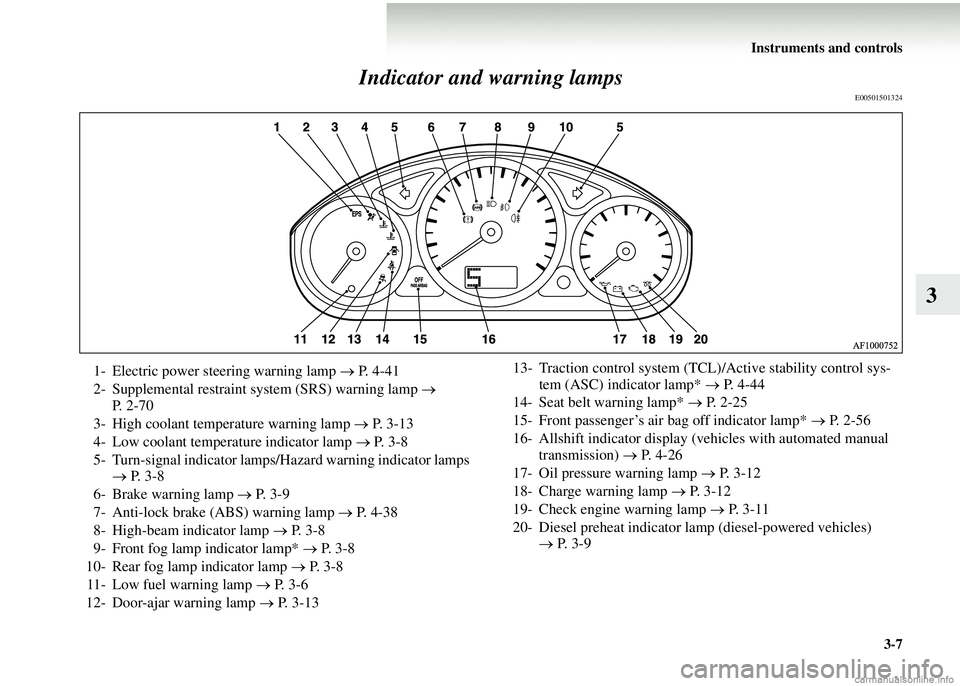
Instruments and controls3-7
3
Indicator and warning lamps
E00501501324
1- Electric power steering warning lamp
→ P. 4-41
2- Supplemental restraint system (SRS) warning lamp →
P. 2 - 7 0
3- High coolant temperature warning lamp → P. 3-13
4- Low coolant temperature indicator lamp → P. 3-8
5- Turn-signal indicator lamps/Hazard warning indicator lamps → P. 3-8
6- Brake warning lamp → P. 3-9
7- Anti-lock brake (ABS) warning lamp → P. 4-38
8- High-beam indicator lamp → P. 3-8
9- Front fog lamp indicator lamp* → P. 3-8
10- Rear fog lamp indicator lamp → P. 3-8
11- Low fuel warning lamp → P. 3-6
12- Door-ajar warning lamp → P. 3-13 13- Traction control system (TCL)/Active stability control sys-
tem (ASC) indicator lamp* → P. 4-44
14- Seat belt warning lamp* → P. 2 - 2 5
15- Front passenger’s air bag off indicator lamp* → P. 2-56
16- Allshift indicator display (vehicles with automated manual transmission) → P. 4-26
17- Oil pressure warning lamp → P. 3-12
18- Charge warning lamp → P. 3-12
19- Check engine warning lamp → P. 3 - 1 1
20- Diesel preheat indicator lamp (diesel-powered vehicles) → P. 3-9
Page 167 of 450
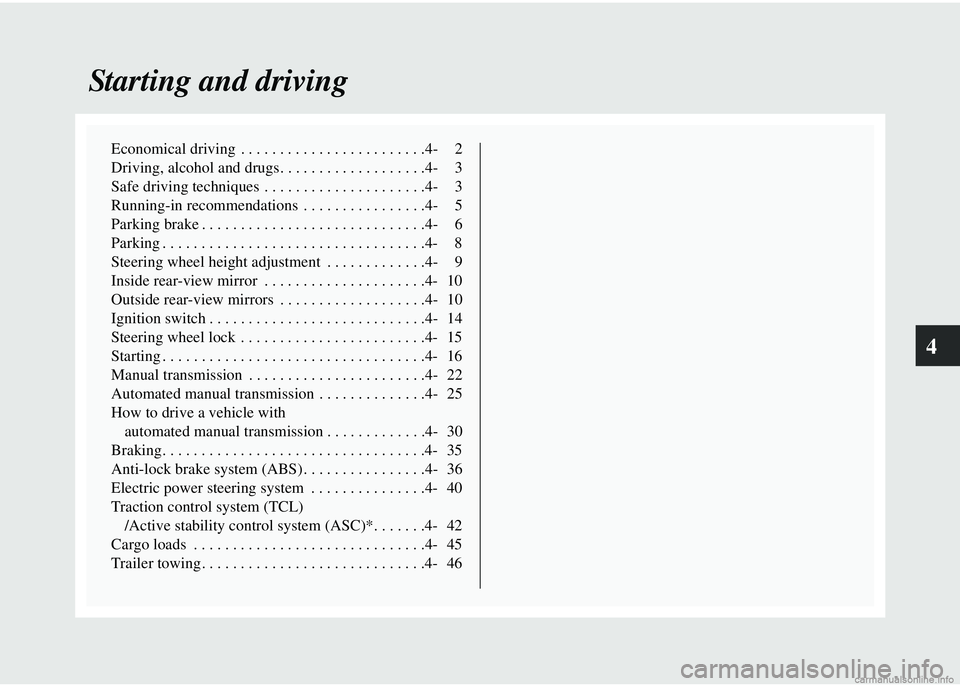
4
Starting and driving
Economical driving . . . . . . . . . . . . . . . . . . . . . . . .4- 2
Driving, alcohol and drugs. . . . . . . . . . . . . . . . . . .4- 3
Safe driving techniques . . . . . . . . . . . . . . . . . . . . .4- 3
Running-in recommendations . . . . . . . . . . . . . . . .4- 5
Parking brake . . . . . . . . . . . . . . . . . . . . . . . . . . . . .4- 6
Parking . . . . . . . . . . . . . . . . . . . . . . . . . . . . . . . . . .4- 8
Steering wheel height adjustment . . . . . . . . . . . . .4- 9
Inside rear-view mirror . . . . . . . . . . . . . . . . . . . . .4- 10
Outside rear-view mirrors . . . . . . . . . . . . . . . . . . .4- 10
Ignition switch . . . . . . . . . . . . . . . . . . . . . . . . . . . .4- 14
Steering wheel lock . . . . . . . . . . . . . . . . . . . . . . . .4- 15
Starting . . . . . . . . . . . . . . . . . . . . . . . . . . . . . . . . . .4- 16
Manual transmission . . . . . . . . . . . . . . . . . . . . . . .4- 22
Automated manual transmission . . . . . . . . . . . . . .4- 25
How to drive a vehicle with automated manual transmission . . . . . . . . . . . . .4- 30
Braking. . . . . . . . . . . . . . . . . . . . . . . . . . . . . . . . . .4- 35
Anti-lock brake system (ABS) . . . . . . . . . . . . . . . .4- 36
Electric power steering system . . . . . . . . . . . . . . .4- 40
Traction control system (TCL) /Active stability control syst em (ASC)*. . . . . . .4- 42
Cargo loads . . . . . . . . . . . . . . . . . . . . . . . . . . . . . .4- 45
Trailer towing. . . . . . . . . . . . . . . . . . . . . . . . . . . . .4- 46
Page 208 of 450

4-42 Starting and driving
4Traction control system (TCL)/Active
stability control system (ASC)
*
E00611700033
The traction control system (TCL )/active stability control sys-
tem (ASC) takes overall control of the anti-lock brake system,
traction control system and activ e stability control system to
help maintain the vehicle’s control and traction. Please read
this section in conjunction with the page on the anti-lock brake
system, traction control system and active stability control sys-
tem.
Anti-lock brake system (ABS) → P. 4-36
Traction control system (TCL) → P. 4-43
Active stability control system (ASC) → P. 4 - 4 3
NOTE● Immediately after the vehicle starts moving after engine
start up, a whining sound of a motor will be heard from
the engine compartment. If the brake pedal is depressed at
that moment, a brake pedal pulsating is felt.
This whining sound and pulsation are due to the self-diag-
nosis operation of the traction control system (TCL)/
active stability control system (ASC) and does not indi-
cate a malfunction.
● Some vibration will be felt in the vehicle body and a
whining sound of a motor will be heard from the engine
compartment when the tract ion control system (TCL)/
active stability control system (ASC) functions. This is a
normal result of the traction control system (TCL)/active
stability control system (ASC) operation, and does not
indicate a malfunction.
● The traction control system (T CL)/active stability control
system (ASC) does not operate while the ABS warning
lamp is illuminated.
CAUTION!
● Do not over-rely on the traction control system
(TCL)/active stability control system (ASC). Even
when the traction control system (TCL)/active sta-
bility control system (ASC ) is operating, there are
limits to the system and its ability to maintain con-
trol and traction. Reckless driving may lead to acci-
dents. Always drive carefully, taking account of the
road conditions.
● Be sure to use the same specified type and size of
tyre on all 4 wheels. Otherw ise, there is a possibility
that the traction control system (TCL)/active stabil-
ity control system (ASC) will not work properly.
Page 209 of 450
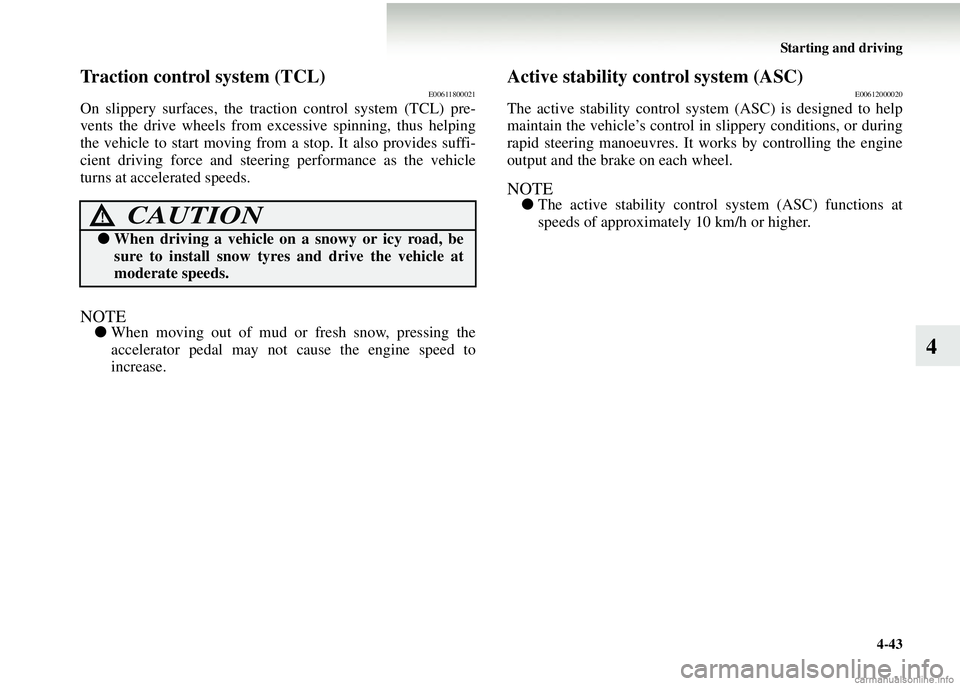
Starting and driving4-43
4
Traction control system (TCL)E00611800021
On slippery surfaces, the traction control system (TCL) pre-
vents the drive wheels from exces sive spinning, thus helping
the vehicle to start m oving from a stop. It also provides suffi-
cient driving force and steerin g performance as the vehicle
turns at accelerated speeds.
NOTE● When moving out of mud or fresh snow, pressing the
accelerator pedal may not cause the engine speed to
increase.
Active stability control system (ASC)E00612000020
The active stability control syst em (ASC) is designed to help
maintain the vehicle’s control in slippery conditions, or during
rapid steering manoeuvres. It works by controlling the engine
output and the brake on each wheel.
NOTE● The active stability control system (ASC) functions at
speeds of approximately 10 km/h or higher.CAUTION!
● When driving a vehicle on a snowy or icy road, be
sure to install snow tyre s and drive the vehicle at
moderate speeds.
Page 210 of 450
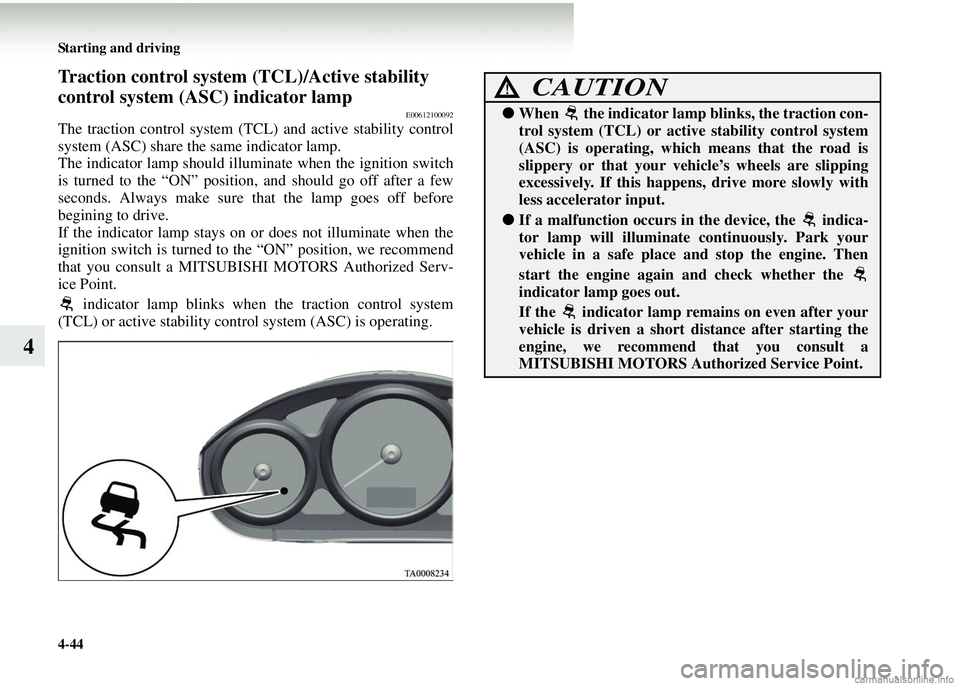
4-44 Starting and driving
4
Traction control system (TCL)/Active stability
control system (ASC) indicator lamp
E00612100092
The traction control system (TCL ) and active stability control
system (ASC) share the same indicator lamp.
The indicator lamp should illuminate when the ignition switch
is turned to the “ON” position, and should go off after a few
seconds. Always make sure that the lamp goes off before
begining to drive.
If the indicator lamp stays on or does not illuminate when the
ignition switch is turned to the “ON” position, we recommend
that you consult a MITSUBISHI MOTORS Authorized Serv-
ice Point.
indicator lamp blinks when the traction control system
(TCL) or active stability contro l system (ASC) is operating.
CAUTION!
●When the indicator lamp blinks, the traction con-
trol system (TCL) or acti ve stability control system
(ASC) is operating, which means that the road is
slippery or that your vehicle’s wheels are slipping
excessively. If this happens, drive more slowly with
less accelerator input.
● If a malfunction occurs in the device, the indica-
tor lamp will illuminate continuously. Park your
vehicle in a safe place and stop the engine. Then
start the engine again and check whether the
indicator lamp goes out.
If the indicator lamp re mains on even after your
vehicle is driven a short distance after starting the
engine, we recommend that you consult a
MITSUBISHI MOTORS Authorized Service Point.
Page 211 of 450
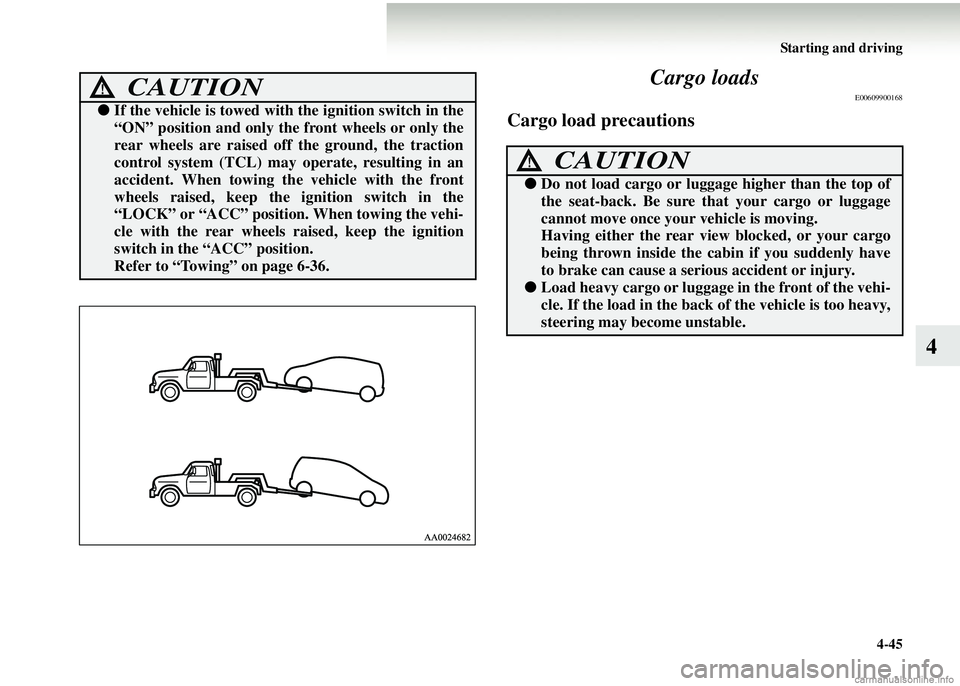
Starting and driving4-45
4
Cargo loads
E00609900168
Cargo load precautions
CAUTION!
●
If the vehicle is towed with the ignition switch in the
“ON” position and only the front wheels or only the
rear wheels are raised off the ground, the traction
control system (TCL) may operate, resulting in an
accident. When towing th e vehicle with the front
wheels raised, keep the ig nition switch in the
“LOCK” or “ACC” position. When towing the vehi-
cle with the rear wheels raised, keep the ignition
switch in the “ACC” position.
Refer to “Towing” on page 6-36.
CAUTION!
● Do not load cargo or luggage higher than the top of
the seat-back. Be sure that your cargo or luggage
cannot move once your vehicle is moving.
Having either the rear view blocked, or your cargo
being thrown inside the cabin if you suddenly have
to brake can cause a serious accident or injury.
●Load heavy cargo or luggage in the front of the vehi-
cle. If the load in the back of the vehicle is too heavy,
steering may become unstable.
Page 327 of 450
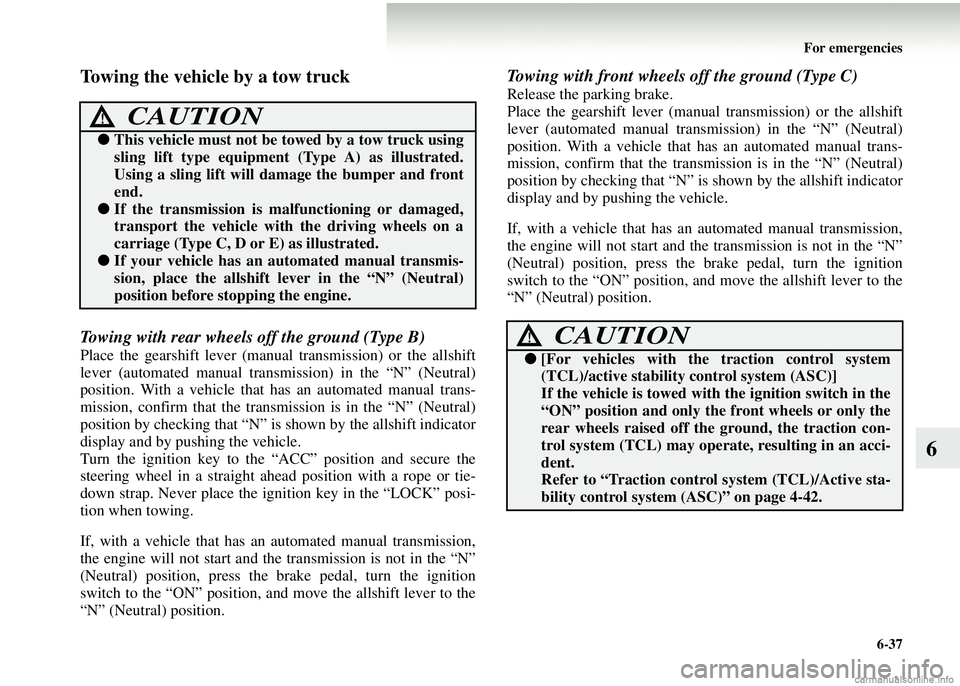
For emergencies6-37
6
Towing the vehicle by a tow truck
Towing with rear wheels off the ground (Type B)
Place the gearshift lever (manual transmission) or the allshift
lever (automated manual transm ission) in the “N” (Neutral)
position. With a vehicle that has an automated manual trans-
mission, confirm that the transm ission is in the “N” (Neutral)
position by checking that “N” is shown by the allshift indicator
display and by pushing the vehicle.
Turn the ignition key to the “ACC” position and secure the
steering wheel in a straight ah ead position with a rope or tie-
down strap. Never place the igni tion key in the “LOCK” posi-
tion when towing.
If, with a vehicle that has an automated manual transmission,
the engine will not start and the transmission is not in the “N”
(Neutral) position, press the brake pedal, turn the ignition
switch to the “ON” position, and move the allshift lever to the
“N” (Neutral) position.
Towing with front wheels off the ground (Type C)
Release the parking brake.
Place the gearshift lever (manual transmission) or the allshift
lever (automated manual transm ission) in the “N” (Neutral)
position. With a vehicle that has an automated manual trans-
mission, confirm that the transmi ssion is in the “N” (Neutral)
position by checking th at “N” is shown by the allshift indicator
display and by pushing the vehicle.
If, with a vehicle that has an automated manual transmission,
the engine will not start and th e transmission is not in the “N”
(Neutral) position, press the brake pedal, turn the ignition
switch to the “ON” position, and move the allshift lever to the
“N” (Neutral) position.
CAUTION!
● This vehicle must not be towed by a tow truck using
sling lift type equipment (Type A) as illustrated.
Using a sling lift will da mage the bumper and front
end.
● If the transmission is malfunctioning or damaged,
transport the vehicle with the driving wheels on a
carriage (Type C, D or E) as illustrated.
●If your vehicle has an automated manual transmis-
sion, place the a llshift lever in the “N” (Neutral)
position before stopping the engine.
CAUTION!
● [For vehicles with the traction control system
(TCL)/active stability control system (ASC)]
If the vehicle is towed with the ignition switch in the
“ON” position and only th e front wheels or only the
rear wheels raised off the ground, the traction con-
trol system (TCL) may operate, resulting in an acci-
dent.
Refer to “Traction control system (TCL)/Active sta-
bility control system (ASC)” on page 4-42.
Page 442 of 450
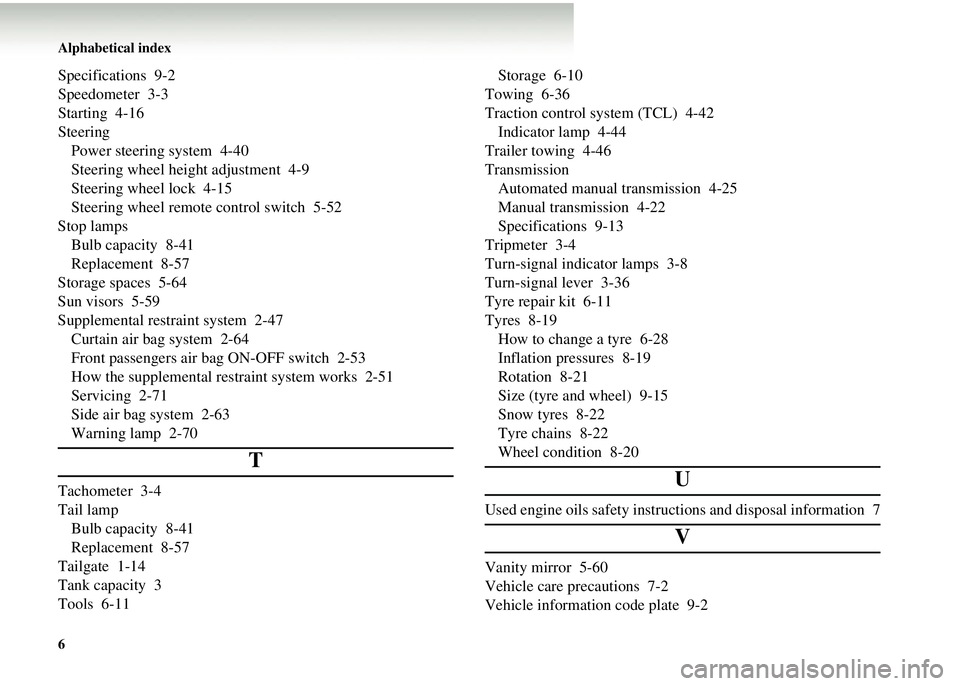
Alphabetical index
6
Specifications 9-2
Speedometer 3-3
Starting 4-16
SteeringPower steering system 4-40
Steering wheel height adjustment 4-9
Steering wheel lock 4-15
Steering wheel remote control switch 5-52
Stop lamps Bulb capacity 8-41
Replacement 8-57
Storage spaces 5-64
Sun visors 5-59
Supplemental restraint system 2-47 Curtain air bag system 2-64
Front passengers air bag ON-OFF switch 2-53
How the supplemental restraint system works 2-51
Servicing 2-71
Side air bag system 2-63
Warning lamp 2-70
T
Tachometer 3-4
Tail lampBulb capacity 8-41
Replacement 8-57
Tailgate 1-14
Tank capacity 3
Tools 6-11 Storage 6-10
Towing 6-36
Traction control system (TCL) 4-42 Indicator lamp 4-44
Trailer towing 4-46
Transmission Automated manual transmission 4-25
Manual transmission 4-22
Specifications 9-13
Tripmeter 3-4
Turn-signal indicator lamps 3-8
Turn-signal lever 3-36
Tyre repair kit 6-11
Tyres 8-19 How to change a tyre 6-28
Inflation pressures 8-19
Rotation 8-21
Size (tyre and wheel) 9-15
Snow tyres 8-22
Tyre chains 8-22
Wheel condition 8-20U
Used engine oils safety instructions and disposal information 7
V
Vanity mirror 5-60
Vehicle care precautions 7-2
Vehicle information code plate 9-2